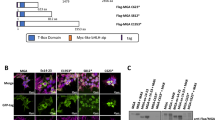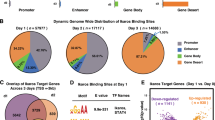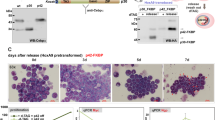Abstract
The chimeric transcription factor E2a-Pbx1 is expressed as a result of the 1;19 chromosomal translocation in some 5% of cases of pediatric acute lymphoblastic leukemia. We investigated the biological and transcriptional consequences of forced expression of E2a-Pbx1 in the interleukin-3 (IL-3) dependent, bone marrow-derived cell line Ba/F3. We show that forced expression of E2a-Pbx1 induces apoptosis in Ba/F3 cells without apparent effects on cell cycle progression. This pro-apoptotic effect is enhanced on cytokine deprivation. Furthermore, using cDNA representational difference analysis (RDA), we show that these cellular effects are associated with marked induction of the gene NDRG1, which was previously identified as a target of transcriptional repression by N-myc and induction by the tumor suppressor protein p53. We identify a portion of the NDRG1 promoter capable of mediating transcriptional induction by E2a-Pbx1 and show that NDRG1 is also induced on simple IL-3 deprivation of BaF3 cells. Although we show that E2a-Pbx1 induction of NDRG1 is not impaired as a result of targeting p53 using HPV E6, and therefore does not appear to be p53-dependent, our results overall are consistent with the notion that induction of NDRG1 by E2a-Pbx1 may represent part of an apoptotic or cytostatic cellular response to oncogene activation.
This is a preview of subscription content, access via your institution
Access options
Subscribe to this journal
Receive 12 print issues and online access
$259.00 per year
only $21.58 per issue
Buy this article
- Purchase on Springer Link
- Instant access to full article PDF
Prices may be subject to local taxes which are calculated during checkout








Similar content being viewed by others
References
Nourse J, Mellentin JD, Galili N, Wilkinson J, Stanbridge E, Smith SD, Cleary ML . Chromosomal translocation t(1;19) results in synthesis of a homeobox fusion mRNA that codes for a potential chimeric transcription factor Cell 1990 60: 535–545
Murre C, Bain G, van Dijk MA, Engel I, Furnari BA, Massari ME, Matthews JR, Quong MW, Rivera RR, Stuiver MH . Structure and function of helix–loop–helix proteins Biochim Biophys Acta 1994 1218: 129–135
Quong MW, Massari ME, Zwart R, Murre C . A new transcriptional-activation motif restricted to a class of helix–loop–helix proteins is functionally conserved in both yeast and mammalian cells Mol Cell Biol 1993 13: 792–800
Aronheim A, Shiran R, Rosen A, Walker MD . The E2A gene product contains two separable and functionally distinct transcription activation domains Proc Nat Acad Sci USA 1993 90: 8063–8067
Zhuang Y, Soriano P, Weintraub H . The helix–loop–helix gene E2A is required for B cell formation Cell 1994 79: 875–884
Bain G, Robanus Maandag EC, Izon DJ, Amsen D, Kruisbeek AM, Weintraub BC, Krop I, Schlissel MS, Feeney AJ, van Roon M, van der Valk M, te Riele HPJ, Berns A, Murre C . E2a proteins are required for proper B cell development and initiation of immunoglobulin gene rearrangements Cell 1994 79: 885–892
Bain G, Engel I, Robanus Maandag EC, te Riele HP, Voland JR, Sharp LL, Chun J, Huey B, Pinkel D, Murre C . E2A deficiency leads to abnormalities in α/β T-cell development and to rapid development of T-cell lymphomas Mol Cell Biol 1997 17: 4782–4791
Gehring WJ, Affolter M, Burglin T . Homeodomain proteins Ann Rev Biochem 1994 63: 487–526
Lu Q, Knoepfler PS, Scheele J, Wright DD, Kamps MP . Both Pbx1 and E2A-Pbx1 bind the DNA motif ATCAATCAA cooperatively with the products of multiple murine Hox genes, some of which are themselves oncogenes Mol Cell Biol 1995 15: 3786–3795
Chang CP, Shen WF, Rozenfeld S, Lawrence HJ, Largman C, Cleary ML . Pbx proteins display hexapeptide-dependent cooperative DNA binding with a subset of Hox proteins Genes Dev 1995 9: 663–674
Phelan ML, Rambaldi I, Featherstone MS . Cooperative interactions between HOX and PBX proteins mediated by a conserved peptide motif Mol Cell Biol 1995 15: 3989–3997
Selleri L, Jacobs Y, Choe S, Chanda S, O'Gorman S, Cleary ML . The Hox-cofactor Pbx1 is required for normal development of proximal limb and axial skeleton and for spleen morphogenesis Blood 1999 92: A1265–A1265
Monica K, LeBrun DP, Dedera DA, Brown RB, Cleary ML . Transformation properties of the E2a-Pbx1 chimeric oncoprotein: fusion with E2a is essential, but the Pbx1 homeodomain is dispensable Mol Cell Biol 1994 14: 8304–8314
Kamps MP, Baltimore D . E2A-Pbx1, the t(1;19) translocation protein of human pre-B-cell acute lymphocytic leukemia, causes acute myeloid leukemia in mice Mol Cell Biol 1993 13: 351–357
Dedera DA, Waller EK, LeBrun DP, Sen-Majumdar A, Stevens ME, Barsh GS, Cleary ML . Chimeric homeobox gene E2A-PBX1 induces proliferation, apoptosis, and malignant lymphomas in transgenic mice Cell 1993 74: 833–843
Fu X, Kamps MP . E2a-Pbx1 induces aberrant expression of tissue-specific and developmentally regulated genes when expressed in NIH 3T3 fibroblasts Mol Cell Biol 1997 17: 1503–1512
Fu X, McGrath S, Pasillas M, Nakazawa S, Kamps MP . EB-1, a tyrosine kinase signal transduction gene, is transcriptionally activated in the t(1;19) subset of pre-B ALL, which express oncoprotein E2a-Pbx1 Oncogene 1999 18: 4920–4929
Fu X, Roberts WG, Nobile V, Shapiro R, Kamps MP . mAngiogenin-3, a target gene of oncoprotein E2a-Pbx1, encodes a new angiogenic member of the angiogenin family Growth Factors 1999 17: 125–137
McWhirter JR, Goulding M, Weiner JA, Chun J, Murre C . A novel fibroblast growth factor gene expressed in the developing nervous system is a downstream target of the chimeric homeodomain oncoprotein E2A-Pbx1 Development 1997 124: 3221–3232
de Lau WB, Hurenkamp J, Berendes P, Touw IP, Clevers HC, van Dijk MA . The gene encoding the granulocyte colony-stimulating factor receptor is a target for deregulation in pre-B ALL by the t(1;19)-specific oncoprotein E2A-Pbx1 Oncogene 1998 17: 503–510
McWhirter JR, Neuteboom ST, Wancewicz EV, Monia BP, Downing JR, Murre C . Oncogenic homeodomain transcription factor E2A-Pbx1 activates a novel WNT gene in pre-B acute lymphoblastoid leukemia Proc Natl Acad Sci USA 1999 96: 11464–11469
Cook DM, Hinkes MT, Bernfield M, Rauscher FJ III . Transcriptional activation of the syndecan-1 promoter by the Wilms’ tumor protein WT1 Oncogene 1996 13: 1789–1799
Hubank M, Schatz DG . Identifying differences in mRNA expression by representational difference analysis of cDNA Nucleic Acids Res 1994 22: 5640–5648
Kokame K, Kato H, Miyata T . Homocysteine-respondent genes in vascular endothelial cells identified by differential display analysis. GRP78/BiP and novel genes J Biol Chem 1996 271: 29659–29665
van Belzen N, Dinjens WN, Diesveld MP, Groen NA, van der Made AC, Nozawa Y, Vlietstra R, Trapman J, Bosman FT . A novel gene which is up-regulated during colon epithelial cell differentiation and down-regulated in colorectal neoplasms Lab Invest 1997 77: 85–92
Zhou D, Salnikow K, Costa M . Cap43, a novel gene specifically induced by Ni2+ compounds Cancer Res 1998 58: 2182–2189
Kurdistani SK, Arizti P, Reimer CL, Sugrue MM, Aaronson SA, Lee SW . Inhibition of tumor cell growth by RTP/rit42 and its responsiveness to p53 and DNA damage Cancer Res 1998 58: 4439–4444
Yu J, Zhang L, Hwang PM, Rago C, Kinzler KW, Vogelstein B . Identification and classification of p53-regulated genes Proc Natl Acad Sci USA 1999 96: 14517–14522
Shimono A, Okuda T, Kondoh H . N-myc-dependent repression of Ndr1, a gene identified by direct subtraction of whole mouse embryo cDNAs between wild type and N-myc mutant Mech Dev 1999 83: 39–52
Lin TM, Chang C . Cloning and characterization of TDD5, an androgen target gene that is differentially repressed by testosterone and dihydrotestosterone Proc Natl Acad Sci USA 1997 94: 4988–4993
Smith KS, Jacobs Y, Chang CP, Cleary ML . Chimeric oncoprotein E2a-Pbx1 induces apoptosis of hematopoietic cells by a p53-independent mechanism that is suppressed by Bcl-2 Oncogene 1997 14: 2917–2926
Tommasino M, Crawford L . Human papillomavirus E6 and E7: proteins which deregulate the cell cycle Bioessays 1995 17: 509–518
Canman CE, Gilmer TM, Coutts SB, Kastan MB . Growth factor modulation of p53-mediated growth arrest versus apoptosis Genes Dev 1995 9: 600–611
Levine AJ . p53, the cellular gatekeeper for growth and division Cell 1997 88: 323–331
Marin MC, Jost CA, Irwin MS, DeCaprio JA, Caput D, Kaelin WG Jr . Viral oncoproteins discriminate between p53 and the p53 homolog p73 Mol Cell Biol 1998 18: 6316–6324
Ulrix W, Swinnen JV, Heyns W, Verhoeven G . The differentiation-related gene 1, Drg1, is markedly upregulated by androgens in LNCaP prostatic adenocarcinoma cells FEBS Lett 1999 455: 23–26
van Belzen N, Dinjens WN, Eussen BH, Bosman FT . Expression of differentiation-related genes in colorectal cancer: possible implications for prognosis Histol Histopathol 1998 13: 1233–1242
Piquemal D, Joulia D, Balaguer P, Basset A, Marti J, Commes T . Differential expression of the RTP/Drg1/Ndr1 gene product in proliferating and growth arrested cells Biochim Biophys Acta 1999 1450: 364–373
Xu B, Lin L, Rote NS . Identification of a stress-induced protein during human trophoblast differentiation by differential display analysis Biol Rep 1999 61: 681–686
Kokawa K, Shikone T, Nakano R . Apoptosis in human chorionic villi and decidua during normal embryonic development and spontaneous abortion in the first trimester Placenta 1998 19: 21–26
Runic R, Lockwood CJ, LaChapelle L, Dipasquale B, Demopoulos RI, Kumar A, Guller S . Apoptosis and Fas expression in human fetal membranes J Clin Endocrinol Metab 1998 83: 660–666
Philipsen S, Suske G . A tale of three fingers: the family of mammalian Sp/XKLF transcription factors Nucleic Acids Res 1999 27: 2991–3000
Acknowledgements
We thank Drs Gerald Krystal, Frank Rauscher, Gary Nolan and Gordon Peters for providing reagents, as indicated in the text, and Dr Stephen Hunger for providing WEHI-3B cells and helpful comments on the manuscript. This work was supported by operating grants from The Hospital for Sick Children Foundation and The National Cancer Institute of Canada.
Author information
Authors and Affiliations
Rights and permissions
About this article
Cite this article
Rutherford, M., Bayly, G., Matthews, B. et al. The leukemogenic transcription factor E2a-Pbx1 induces expression of the putative N-myc and p53 target gene NDRG1 in Ba/F3 cells. Leukemia 15, 362–370 (2001). https://doi.org/10.1038/sj.leu.2402059
Received:
Accepted:
Issue Date:
DOI: https://doi.org/10.1038/sj.leu.2402059
Keywords
This article is cited by
-
PBX1: a key character of the hallmarks of cancer
Journal of Molecular Medicine (2021)
-
Increased NDRG1 Expression is Associated with Advanced T Stages and Poor Vascularization in Non-small Cell Lung Cancer
Pathology & Oncology Research (2012)
-
Evaluation of glucocorticoid sensitivity in 697 pre-B acute lymphoblastic leukemia cells after overexpression or silencing of MAP kinase phosphatase-1
Journal of Cancer Research and Clinical Oncology (2005)



